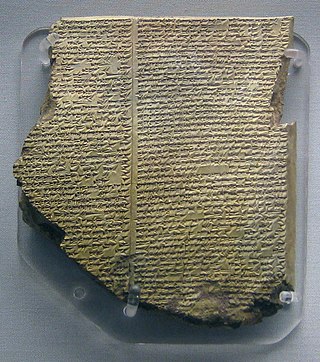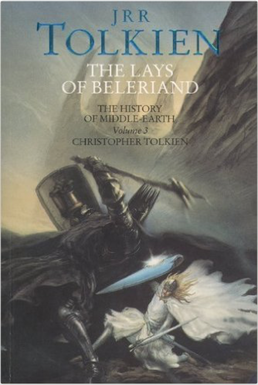
An epic poem, or simply an epic, is a lengthy narrative poem typically about the extraordinary deeds of extraordinary characters who, in dealings with gods or other superhuman forces, gave shape to the mortal universe for their descendants.
A heroic couplet is a traditional form for English poetry, commonly used in epic and narrative poetry, and consisting of a rhyming pair of lines in iambic pentameter. Use of the heroic couplet was pioneered by Geoffrey Chaucer in the Legend of Good Women and the Canterbury Tales, and generally considered to have been perfected by John Dryden and Alexander Pope in the Restoration Age and early 18th century respectively.

Poetry, also called verse, is a form of literature that uses aesthetic and often rhythmic qualities of language − such as phonaesthetics, sound symbolism, and metre − to evoke meanings in addition to, or in place of, a prosaic ostensible meaning. A poem is a literary composition, written by a poet, using this principle.
Rhyme royal is a rhyming stanza form that was introduced to English poetry by Geoffrey Chaucer. The form enjoyed significant success in the fifteenth century and into the sixteenth century. It has had a more subdued but continuing influence on English verse in more recent centuries.
A rhyme scheme is the pattern of rhymes at the end of each line of a poem or song. It is usually referred to by using letters to indicate which lines rhyme; lines designated with the same letter all rhyme with each other.

The Lays of Beleriand, published in 1985, is the third volume of Christopher Tolkien's 12-volume book series, The History of Middle-earth, in which he analyzes the unpublished manuscripts of his father J. R. R. Tolkien.
Mormon fiction is generally fiction by or about members of the Church of Jesus Christ of Latter-day Saints, who are also referred to as Latter-day Saints or Mormons. Its history is commonly divided into four sections as first organized by Eugene England: foundations, home literature, the "lost" generation, and faithful realism. During the first fifty years of the church's existence, 1830–1880, fiction was not popular, though Parley P. Pratt wrote a fictional Dialogue between Joseph Smith and the Devil. With the emergence of the novel and short stories as popular reading material, Orson F. Whitney called on fellow members to write inspirational stories. During this "home literature" movement, church-published magazines published many didactic stories and Nephi Anderson wrote the novel Added Upon. The generation of writers after the home literature movement produced fiction that was recognized nationally but was seen as rebelling against home literature's outward moralization. Vardis Fisher's Children of God and Maurine Whipple's The Giant Joshua were prominent novels from this time period. In the 1970s and 1980s, authors started writing realistic fiction as faithful members of the LDS Church. Acclaimed examples include Levi S. Peterson's The Backslider and Linda Sillitoe's Sideways to the Sun. Home literature experienced a resurgence in popularity in the 1980s and 1990s when church-owned Deseret Book started to publish more fiction, including Gerald Lund's historical fiction series The Work and the Glory and Jack Weyland's novels.

Orson Ferguson Whitney, born in Salt Lake City, Utah Territory, was a member of the Quorum of the Twelve Apostles of the Church of Jesus Christ of Latter-day Saints from 1906 until his death.

Childe Harold's Pilgrimage is a long narrative poem in four parts written by Lord Byron. The poem was published between 1812 and 1818. Dedicated to "Ianthe", it describes the travels and reflections of a world-weary young man, who is disillusioned with a life of pleasure and revelry and looks for distraction in foreign lands. In a wider sense, it is an expression of the melancholy and disillusionment felt by a generation weary of the wars of the post-Revolutionary and Napoleonic eras. The title comes from the term childe, a medieval title for a young man who was a candidate for knighthood.

A verse novel is a type of narrative poetry in which a novel-length narrative is told through the medium of poetry rather than prose. Either simple or complex stanzaic verse-forms may be used, but there will usually be a large cast, multiple voices, dialogue, narration, description, and action in a novelistic manner.
Poetic Closure: A Study of How Poems End — ISBN 0-226-76343-9 — is a book by Barbara Herrnstein Smith, which was published by the University of Chicago Press in 1968. The division between form and content in the way the book is structured has been criticized.

This glossary of literary terms is a list of definitions of terms and concepts used in the discussion, classification, analysis, and criticism of all types of literature, such as poetry, novels, and picture books, as well as of grammar, syntax, and language techniques. For a more complete glossary of terms relating to poetry in particular, see Glossary of poetry terms.
This is a glossary of poetry.

Mormon poetry is poetry written by members of the Church of Jesus Christ of Latter-day Saints about spiritual topics or themes. Mormons have a long history of writing poetry relevant to their religious beliefs and to the Mormon experience. Mormon poetry, like Mormon fiction, has experienced different periods throughout the LDS Church's history, including the "home literature" period and the "lost generation." Some Mormon poetry became church hymns.
Political verse, also known as decapentasyllabic verse, is a common metric form in Medieval and Modern Greek poetry. It is an iambic verse of fifteen syllables and has been the main meter of traditional popular and folk poetry since the Byzantine period.
Decasyllabic quatrain is a poetic form in which each stanza consists of four lines of ten syllables each, usually with a rhyme scheme of AABB or ABAB. Examples of the decasyllabic quatrain in heroic couplets appear in some of the earliest texts in the English language, as Geoffrey Chaucer created the heroic couplet and used it in The Canterbury Tales. The alternating form came to prominence in late 16th-century English poetry and became fashionable in the 17th century when it appeared in heroic poems by William Davenant and John Dryden. In the 18th century famous poets such as Thomas Gray continued to use the form in works such as "Elegy Written in a Country Churchyard". Shakespearean Sonnets, comprising 3 quatrains of iambic pentameter followed by a final couplet, as well as later poems in blank verse have displayed the various uses of the decasyllabic quatrain throughout the history of English Poetry.

Selected Manifestations: Being an Unofficial Collection of Temple Dedicatory Prayers, Revelations, Visions, Dreams, Doctrinal Expositions, & Other Inspired Declarations Not Presently Included in the Official Canon of Scriptures Known as the Four Standard Works of the Church of Jesus Christ of Latter-day Saints is a 413-page book self-published in 1985 by David M. and Vonda S. Reay. It is a compilation of scarce, non-canonical revelations of leaders of the Church of Jesus Christ of Latter-day Saints.
Der Messias is an epic poem published from 1748 to 1773 by German poet Friedrich Gottlieb Klopstock.
"Epilogue For W. H. Auden" is a 76-line poem by Louis MacNeice. It was written in late 1936 and was first published in book form in Letters from Iceland, a travel book in prose and verse by W. H. Auden and Louis MacNeice (1937). MacNeice subsequently included it as the last poem in his poetry collection The Earth Compels (1938). "Epilogue For W. H. Auden" reviews the Iceland trip MacNeice and Auden had taken together in the summer of 1936; the poem mentions events that had occurred while MacNeice and Auden were in Iceland, such as the fall of Seville and the Olympic Games in Berlin.
Mador of the Moor is a narrative poem by James Hogg, first published in 1816. Consisting of an Introduction, five cantos, and a Conclusion, it runs to more than two thousand lines, mostly in the Spenserian stanza. Set in late medieval Scotland, it tells of the seduction of a young maiden by a charismatic minstrel and her journey to Stirling in search of him, leading to the revelation that he is the king and finally to their marriage and the christening of their son.







